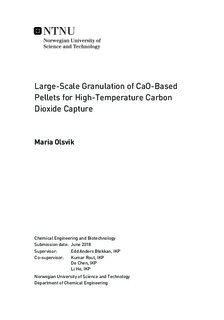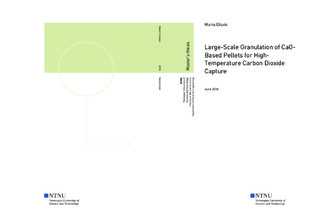| dc.description.abstract | Abstract
Pelletized CaO-based sorbents are made for the use in Moving Bed Carbonate Looping
(MBCL) technology capturing CO2 at a low partial pressure of CO2 and high temperature,
producing approximately 100% pure CO2. Developing this technology will be an important
step in reducing CO2 emissions and prevent temperature increase on the globe. The
main goal of this thesis was to develop a procedure for making these pellets in large scale.
Material properties such as good CO2-capture capacity and stability, and good mechanical
strength are important. A "rotary drum" granulation machine was used to produce
granules made of 100g calcined dolomite/cement ADDA, calcium aluminate cement, extra
magnesium and zirconium with water as a liquid binder. The preparation method lasted
for two days due to the exothermic reaction between dolomite/ADDA and water, and water
was slowly added to avoid early strength gain and increased hydration kinetics at higher
temperatures. Six pellets based on calcined dolomite were made; NO-1 (pure dolomite),
NO-3 (1.9% Zr from nitrates), NO-6 (1.6% Zr from ZrCl4 and 5.8%Al from cement), NO8
(2.9%Mg from magnesium nitrate and 5.5%Al (from cement)), NO-10 (6.1%Al from
cement) and NO-12 (1.6% Zr from nitrates and 5.8%Al from cement). In addition, four
pellets were made of cement ADDA.
Results from nitrogen adsorption/desorption showed largest surface area for unpromoted
pellets and smallest pores for the doped samples. Scanning electron microscope pictures,
and mechanical tests seem to demonstrate good performance of pellets NO-3, NO-8 and
NO-10. They have a similar pellet surface and sphericity, low cumulative attrition loss
and weight loss in each drop in the falling test. The x-ray diffraction identified phases of
mayenite (Ca12Al14O33), which might be the reasons for the excellent mechanical strength
of NO-8 and NO-10.
Results from sorption/desorption cycling in a thermogravimetric analyzer with 8% steam
demonstrated promising CO2-carrying capacity and stability over 34 cycles for all pellets.
Even though sample NO-1 has the worst stability, the stability was surprisingly high
compared to other studies on powdered dolomite which have shown poor cyclic stability.
The reason might be the preparation method and the raw material (calcined dolomite (3h
800◦C) <106µm) used, but further investigation and calibration of the TGA are necessary.
Sample NO-12 showed that the up-scaling procedure is comparable to small-scale
granulation. The best cyclic stability is found for sample NO-8 and NO-12 believed to be
due to doping by magnesium/aluminum, and zirconium/aluminum. Al, Mg, and Zr inhibit
sintering due to higher melting points of the mixed oxides (mayenite and CaZrO3).
The kinetic study demonstrated the fastest reaction rate for 650◦C at a high CO2 concentration
in the reaction controlled regime. At low partial pressures of CO2, 620◦C gave faster
reaction kinetics than 650◦C, due to higher driving force. A pellet size of 250µm-1.2mm
indicated minimal diffusion limitations, and smooth s-curves during sorption at 650◦C,
reaching 80% of their capacity in 5 minutes. | |

